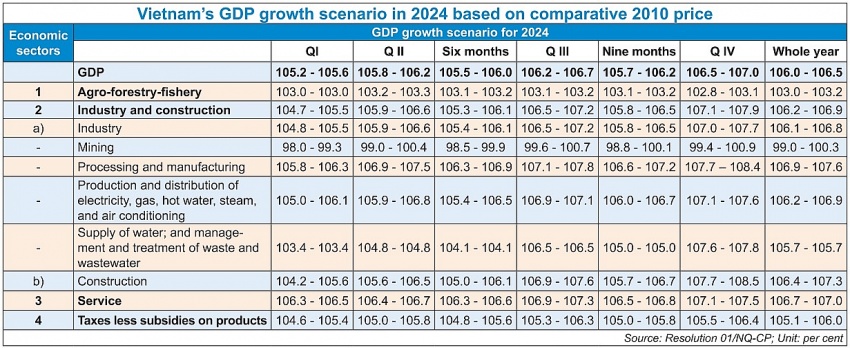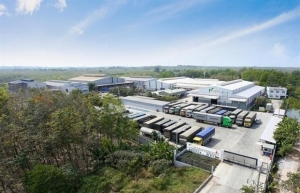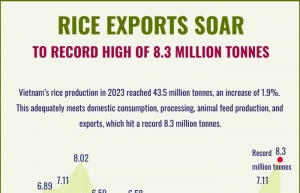Export expansion at centre of growth plan
 |
| Export expansion at centre of growth plan, Source: Shutterstock |
Last week, as it published Resolution No.01/NQ-CP, the government released detailed scenarios for economic growth for 2024 (see box), with an expected export revenue of $376 billion this year, up 6 per cent on-year.
While the country’s GDP last year hit $430 billion, its export-import turnover was 1.58 times higher, reaching $681 billion, down 6.9 per cent or $50.25 billion on-year.
Fresh figures released last week from the General Department of Vietnam Customs showed that, in 2023, exports and imports of goods reached $354.67 billion and $326.37 billion, respectively, down 4.6 and 9.2 per cent, with a trade surplus of 28.3 billion.
To reach the figures in the set-out scenarios, the government has ordered ministries and localities to boost activities on trade promotion, and continue diversification of export markets, products, and supply chains, while having to “create breakthroughs in expanding new export markets, and maximising the use of opportunities from key export markets.”
 |
In 2024, the government will also boost the negotiations and signing of new free trade agreements and implementation of new trade links, while effectively supporting enterprises to well take advantage of commitments in signed deals. It will also bring a trade deal into force with Israel.
The government has also ordered ministries and localities to periodically meet with enterprises to listen to their ideas and proposals to help them remove difficulties, boost customs clearance of goods at border gates, and provide prompt information about technical barriers in export markets, especially new regulations about green production and environmental environment.
The government has also addressed key tasks and solutions to improve Vietnam’s business climate and national competitiveness in 2024. Difficulties must be removed for enterprises and investors so that their performance can be boosted, with the generation of more employment and higher salaries.
The government also required ministries and localities to “speed up the cutting, reduction, and simplification of administrative procedures; improve the business climate; and facilitate and reduce costs for investment and business activities.”
The State Bank of Vietnam was ordered to reduce interest rates quickly and create better conditions for enterprises and individuals to access loans. Credit must be focused on sectors that can serve growth momentum, such as consumption, investment, and export.
The Ministry of Finance, meanwhile, must soon submit new policies on exempting, reducing, and deferring the payment of taxes, fees, and land rental to help struggling enterprises and individuals.
The Ministry of Industry and Trade (MoIT) is now working with Vietnam’s trade offices overseas to seek more information and demand from their markets, to advise the government on how to boost exports.
The Ministry of Planning and Investment has warned of major risks in the global markets, which could affect the Vietnamese economy, mostly exports. The economy is open to the global economy, and the country’s total export-import turnover is much higher than its GDP. Thus, it is prone to be vulnerable to external shocks.
Prime Minister Pham Minh Chinh noted last week that in 2024, the situation in the region and in the wider world will continue to see complicated and unpredictable developments. The consequences of the pandemic will have a long-term impact. Meanwhile, strategic competition between major countries is becoming increasingly fierce, and conflicts in Ukraine and Gaza are likely to continue.
“Domestically, the economy will see both opportunities and challenges, but the challenges will be bigger. Inflationary pressure is still strong. Production and business are forecast to remain difficult, and demand from Vietnam’s large and traditional import and export markets continues to decline.”
According to the MoIT, Vietnam’s big export markets have been reducing their import demands, and this has affected export orders and supply chains.
In 2023, Vietnam recorded many on-year export decreases in many key markets, such as the US (11.6 per cent), South Korea (3.4 per cent), ASEAN (4.1 per cent), the EU (5.9 per cent), and Japan (3.2 per cent). Such falls were severely damaging to the economy.
“Business performance remains in major difficulty. The number of enterprises withdrawing from the market is still very high. This will affect our efforts to generate employment,” PM Chinh said.
According to the GSO, in 2023 a total of 89,100 businesses halted operations – up 20.7 per cent on-year; 65,500 enterprises stopped operations and waited for dissolution procedures – up 28.9 per cent; and 14,400 enterprises completed such procedures.
“Domestic production still largely relies on imported materials, while the demand in the domestic market has narrowed, and Vietnam’s exports to key markets have all suffered on-year reductions,” stated a government report.
The Vietnamese economy grew 5.05 per cent in 2023, and the government has set a target of achieving GDP growth of 6-6.5 per cent this year, based on the expectation that the domestic business and production activities will strongly bounce back.
| Shantanu Chakraborty, country director for Vietnam Asian Development Bank
Public investment disbursement by the end of November reached 75 per cent of the planned expenditure in the year, a significant 22 per cent increase on-year. The disbursement of public investment, though still slow, has partly boosted domestic consumption, at 9.6 per cent in November 2023 over the same period in 2022. Macroeconomic fundamentals remain resilient with timely monetary easing in the first half of the year, while inflation was comfortably controlled below the 4 per cent target by the National Assembly. The fluctuation of the VND-USD exchange rate triggered by the interest rate differential between the US Federal Reserve fund rate and the State Bank of Vietnam’s rates was kept within the 3-5 per cent benchmark range. The key challenges are seen in the real economy, especially the impact of negative trade growth. This is compounded by a short-lived recovery around the third quarter, and lacklustre trade performance since. In 2023, exports were down about 4.4 per cent on-year, while imports fell by over 8.9 per cent on-year. Though there was a trade surplus of $28 billion, it still means that export orders, and consequently export-processing jobs, have not recovered. Another challenge is the slow credit growth, reaching only 8.21 per cent by the end of November against the target of 14.5 per cent. This is an indication that credit demand is growing slowly, a result of the real economy weaknesses, including challenges in the real estate sector. |
 | Vietnam's largest spices exporter receives investment from EU Phuc Sinh JSC has announced that the company successfully sold shares to an investment fund from Europe with an undisclosed amount. |
 | Rice exports soar to record 8.3 million tonnes Vietnam’s rice production in 2023 stood at 43.5 million tonnes, an increase of 1.9 per cent, adequately meeting domestic consumption, processing, animal feed production, and exports, which set a record of nearly 8.3 million tonnes. |
What the stars mean:
★ Poor ★ ★ Promising ★★★ Good ★★★★ Very good ★★★★★ Exceptional
 Tag:
Tag:
Related Contents
Latest News
More News
- Global partnerships key to Vietnam’s IFC development (December 26, 2025 | 16:18)
- Vingroup pulls out of bid to invest in North-South high-speed railway (December 26, 2025 | 11:42)
- Strengthening supply chains through trade promotions and customs reform (December 24, 2025 | 14:00)
- PM orders investment model for North–South high-speed rail (December 22, 2025 | 17:43)
- LS Eco Energy to invest in Vietnam rare earth sector (December 22, 2025 | 17:31)
- Government moves to establish International Financial Centre (December 21, 2025 | 21:00)
- Vietnam's IFC to target global investment flows (December 21, 2025 | 18:00)
- Two national hospitals expand capacity with new facilities (December 20, 2025 | 09:00)
- Ha Tinh breaks ground on major Vingroup industrial and energy projects (December 19, 2025 | 18:24)
- EVN launches major power infrastructure projects nationwide (December 19, 2025 | 18:17)
























 Mobile Version
Mobile Version